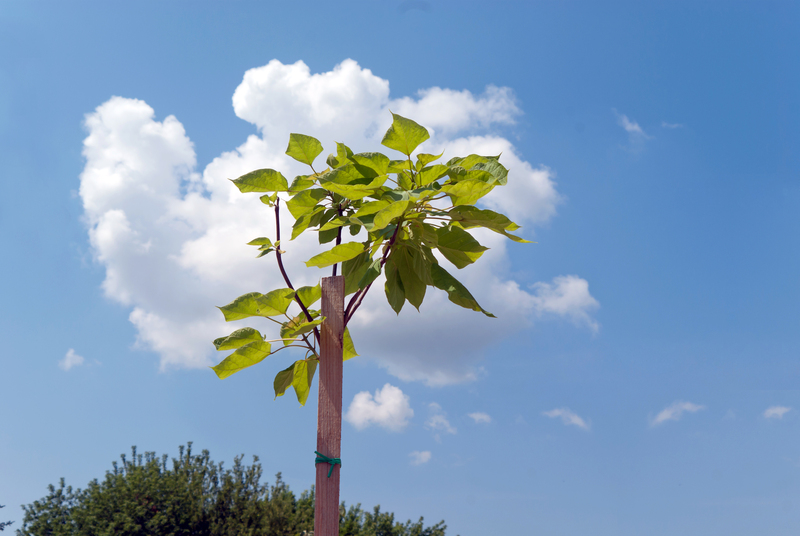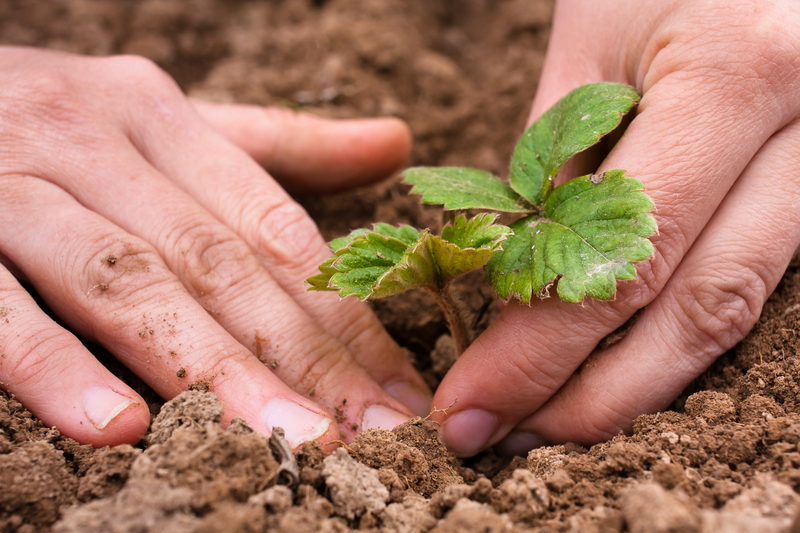Creating Nutrient Oasis from Scraps
Posted on 22/08/2025
Creating a Nutrient Oasis from Scraps: Transforming Waste into Garden Gold
In our fast-paced world, the quest for sustainability has never been more vital. Creating a nutrient oasis from scraps is an ingenious way to turn everyday kitchen and garden waste into a thriving ecosystem, fostering abundant yields and lush greenery. Whether you're an urban gardener with a balcony plot or tending a spacious backyard, transforming scraps into a fertile haven can revolutionize your gardening, reduce landfill contributions, and strengthen your connection to nature.

Why Transform Scraps into Nutrients? The Science Behind the Process
Every year, millions of tons of organic waste find their way to landfills, where decomposition releases methane--a potent greenhouse gas. Composting and recycling these scraps on-site not only diverts this waste but also unlocks a treasure trove of nutrients for your soil, supporting plant health, beneficial microbes, and sustainable food cycles.
- Environmental Impact: Reducing food waste lowers landfill methane emissions.
- Soil Health: Organic matter enriches the soil, improving structure, moisture retention, and fertility.
- Plant Growth: Homemade compost delivers vital nutrients for lush, productive plants and resilient landscapes.
- Economic Benefits: Utilizing scraps saves money on fertilizers and reduces household waste disposal costs.
Understanding the Nutrient Cycle
Mother Nature's grand design ensures no waste is left behind: from fallen leaves to discarded vegetables, everything returns to the Earth, nourishing the cycle anew. By facilitating this natural process and creating edible oases from waste materials, we can foster gardens that thrive with minimal external inputs.
Types of Scraps You Can Transform
Not all scraps are created equal. For optimal results in creating your own nutrient-rich oasis from kitchen scraps, it's vital to distinguish between what can be composted, what's best for direct application, and what should be avoided.
Green Materials
- Fruit and vegetable peels
- Coffee grounds and tea leaves
- Eggshells (crushed)
- Fresh grass clippings
- Plant trimmings without disease
Brown Materials
- Dried leaves
- Cardboard and paper (non-glossy)
- Sawdust (from untreated wood)
- Shredded newspaper
- Straw and hay
Items to Avoid
- Meat, dairy, and oils
- Diseased plants
- Synthetic materials and plastics
- Treated wood shavings
- Excessive citrus and spicy foods
By selecting the right mix of green (nitrogen-rich) and brown (carbon-rich) materials, you'll accelerate the composting process and create a balanced, nutrient-packed output--perfect for a vibrant garden oasis.
Step-by-Step Guide: Building Your Nutrient Oasis from Scraps
1. Collecting and Storing Kitchen Scraps
Begin by designating a bin for kitchen waste. Choose a container with a lid to minimize odors. For frequent chefs, a countertop compost pail is handy, while larger batches can be transferred to an outdoor pile or tumbler. Include fruit and vegetable peels, coffee grounds, tea bags, and eggshells for maximum nutrient variety.
- Tip: Chop larger scraps--like melon rinds or corn cobs--into smaller pieces to speed up decomposition.
- Tip: Store in the refrigerator or freezer if not adding to your pile within a day to prevent smells and pests.
2. Setting Up Your Composting System
You have several options for creating a garden oasis from organic waste:
- Compost Bin or Pile: Designate a spot in your yard for a freestanding pile or enclosed bin. Layer greens and browns, ensuring good aeration.
- Tumbling Composter: Accelerates decomposition by regularly mixing the contents with a crank or spin. Ideal for smaller spaces.
- Vermicomposting (Worm Bin): Great for indoors or apartments. Red wigglers love kitchen scraps and produce nutrient-dense worm castings.
Maintain a ratio of roughly 2 parts brown to 1 part green to keep your compost balanced and odor-free.
3. Accelerating Decomposition: Tips for Faster Results
- Turn your pile weekly to provide oxygen, which feeds beneficial microbes.
- Maintain moisture--your compost should feel like a wrung-out sponge.
- Add layers: alternate wet greens and dry browns.
- Monitor temperature. A hot pile (130-150?F or 54-66?C) works fastest, but cool piles are still effective over time.
4. Harvesting and Using Your Homemade Compost
Finished compost looks dark, crumbly, and smells earthy. It's ready to nourish your plants and transform your home garden into a nutrient oasis.
- Spread 1-2 inches over garden beds as mulch or work gently into the topsoil.
- Mix into potting soil for containers or raised beds.
- Brew compost tea--a simple infusion of compost in water--to use as a nutrient-rich liquid feed for houseplants and seedlings.
Advanced Techniques to Maximize Your Nutrient Oasis
Bokashi Composting
Bokashi is a Japanese composting method that ferments kitchen scraps, including small amounts of meat and dairy. When added to your regular compost or buried, it decomposes rapidly, accelerating the formation of nutritious humus. Bokashi can be a game-changer for urban gardeners or those with limited outdoor space.
Trench Composting
For direct soil enrichment, dig shallow trenches in your garden, add raw scraps, and cover with soil. Over weeks or months, decomposers create natural nutrient reservoirs exactly where your plants can use them. This lazy, low-maintenance method is brilliant for secretively feeding garden beds and fruit trees.
Leaf Mold: Black Gold for the Soil
Don't overlook the humble autumn leaf. By piling leaves, keeping them moist, and letting fungi work their magic, you produce "leaf mold"--a superb soil conditioner that improves water retention and microbial life.
Building a Scraps-Based Oasis Garden
Design Principles for Abundant, Self-Sustaining Plots
- Layering: Build rich soil by adding compost, leaf mold, and mulch annually to prevent nutrient depletion.
- Companion Planting: Use your nutrient-rich beds for guilds of mutually beneficial plants: mix deep-rooted, shallow-rooted, nitrogen-fixing, and flowering varieties.
- Water Conservation: Mulch with finished compost or straw to keep moisture in, furthering the oasis effect.
- Continuous Cycling: Always have a spot for fresh compost or scrap trenches, rotating locations to spread fertility.
Feed the Soil, Not Just the Plants
By nourishing the soil with composted scraps, you create an ecosystem teeming with earthworms, fungi, and beneficial microbes. These unseen allies break down nutrients, deter pests, and support robust plant health--setting the stage for a true nutrient oasis garden.
Common Problems & How To Overcome Them
Odors and Pests
- Prevention: Always cover fresh food scraps with a layer of browns (leaves, straw, cardboard).
- If using an open pile, avoid meat and oily foods. Bins with doors/lids provide extra security.
- Regularly turn or aerate to prevent smelly anaerobic conditions.
Slow Decomposition
- Check moisture and adjust: too wet, add browns; too dry, add greens or a little water.
- Increase surface area by chopping scraps smaller.
- Turn more often; aerobic microbes speed things up.
Weed Seeds or Pathogens
- Hot composting (keeping pile temperatures above 130?F/54?C) destroys pathogens and weed seeds.
- If in doubt, avoid diseased plants and overly seedy weeds as input materials.
The Broader Benefits of a Nutrient Oasis from Waste
Reducing Your Carbon Footprint
Every batch of composted scraps is one less bag bound for landfill, cutting methane emissions and synthetic fertilizer demand. By turning waste into a garden resource, you close the loop and help cool the planet.
Food Security & Self-Reliance
A scrap-fueled edible oasis can yield surprising productivity. With revitalized soil, crops grow faster and more resiliently. This supports household food gardens or even small-scale community plots--making nutritious, chemical-free produce more accessible worldwide.
Education & Engagement
Teaching children and adults alike about recycling nutrients from scraps fosters environmental stewardship and curiosity. Gardening soothes the mind, builds community bonds, and reconnects us with the magic of natural cycles.

Frequently Asked Questions on Creating a Nutrient Oasis from Scraps
Can I compost citrus or onions?
In moderation, citrus peels and onion scraps can be composted, but large quantities may slow decomposition and impact worms in a vermicompost system. If you are worried, toss them into trench compost or municipal collection where industrial processing can handle them.
Is it safe to use compost made from kitchen scraps?
Absolutely! As long as you avoid meats, dairy, and diseased materials, home-composted scraps break down into safe, nutritious humus, perfect for all garden uses.
How do I know when compost is ready?
Finished compost is brown, crumbly, smells earthy and bears little resemblance to its original wastes.
Conclusion: Embrace the Circle--Create Your Own Nutrient Oasis from Scraps
Through curiosity, care, and a little patience, anyone can create a thriving nutrient oasis from food scraps and yard waste. The results are immediate and long-lasting--lush gardens, richer harvests, lighter environmental footprints, and a sense of stewardship for future generations. Start small, stay curious, and celebrate the transformation from "waste" to wow.
Ready to begin? Start saving your scraps today, and let the journey to your own sustainable, nutrient oasis garden begin!

